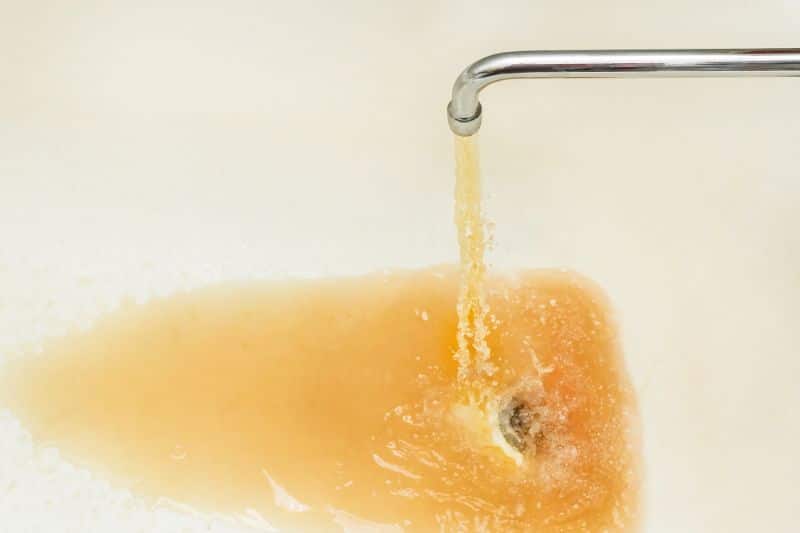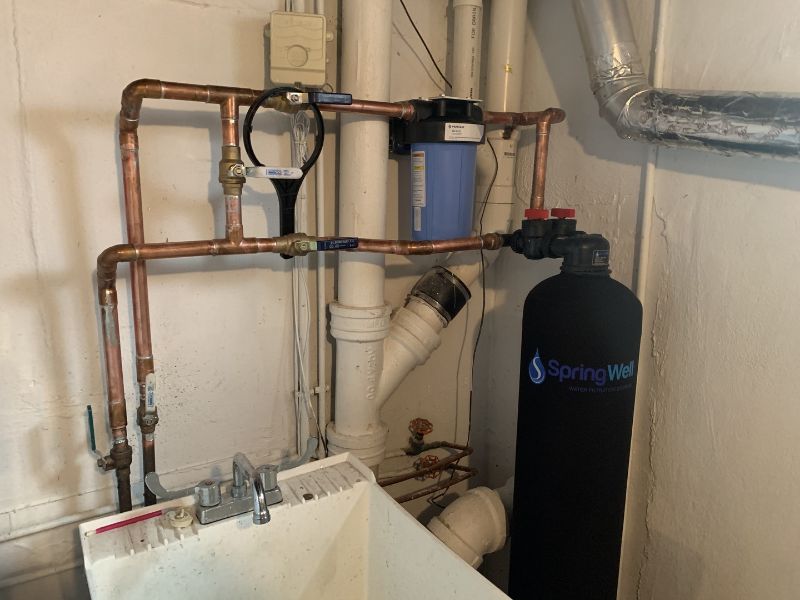Yellow water from your faucets looks unpleasant, but what’s the cause – and should you be concerned?
We’ve been testing and treating drinking water with all manner of contamination issues in the past decade. Here, we’ve shared the most common causes of yellow water based on our own observations.

Table of Contents
🤔 Why is My City Water Yellow?
Yellow municipal water is typically caused by one of the following:
- Corroded faucets – Over time, the insides of your faucets can become worn and corroded. The flow of water through the faucets could dislodge the corroded material, giving your drinking water a yellow tint. You may notice yellow water from only one faucet.
- Rust buildup in your home’s plumbing – An old, dated plumbing system could be corroding or rusting, releasing particles that cause your water to turn yellow. This is likely if your yellow tap water goes clear after the first draw. Corrosion of your plumbing isn’t usually dangerous unless your home was built before 1981 and your plumbing hasn’t been replaced (the CDC says this increases the risk of lead contamination).
- Rust in your water heater – A rusty water heater or hot water tank could release a small amount of rust into your hot water supply, causing it to turn yellow, orange, or brown. In this case, only your hot water will be yellow, while your cold water will be unaffected.
- Mains work – Temporarily discolored water may be caused by your local water company performing mains work on the service lines, such as pipe repairs/maintenance. Sediment dislodging from your municipal utility flushing the lines could also turn your tap water yellow. Contact your water utility to see if maintenance is being performed.
- Mains disruption – A disruption in your municipal water system, such as a burst pipe or fire hydrant use, may cause water pressure changes that dislodge sediments in the pipes running to your home, giving your water supply a yellow tinge.
Public water utilities must conform to the EPA Drinking Water Regulations and reduce contaminants down to safe trace levels, so discoloration is unlikely to be caused by a water quality issue in city water.
Related: Why is my toilet water yellow?

🧐 Why is My Well Water Yellow?
Yellow well water could also be caused by corroded pipes, water heaters, or faucets in your home, but it’s most likely a water quality issue.
There are several common groundwater contaminants that give water a yellow tinge, including:
- Ferric iron – Ferric or insoluble iron is found in most groundwater wells. Iron-laced water may look yellow due to the formation of ferric hydroxide, which can precipitate out of water, forming small particles that scatter light and give the water a yellow or brownish tint. Other signs of iron in your water include a metallic taste and rust deposits on surfaces.
- Tannins – Tannins can give well water a yellow or brown color when they leach into the water from decaying vegetation and organic material. They’re soluble in water to some extent, and the intensity of the color depends on the concentration of tannins present.
- Sediment – Certain natural minerals and organics that contribute to sediment in water, including rust particles, manganese oxide, and organic matter, can turn it yellow.
- Iron bacteria – Bacteria thrive in environments with high iron levels, like groundwater containing ferrous iron. Iron bacteria oxidize ferrous iron to ferric iron, producing a yellowish precipitate called ferric hydroxide. According to the Water Quality Association, iron bacteria can also clog pipes and affect flow rates in plumbing/appliances.
The CDC advises that you test your well water supply at least once a year for pH, total coliform bacteria, total dissolved solids, and nitrates. But if you suspect the presence of any other contaminants, such as those that turn tap water yellow, test for them too. Once you know what your drinking water contains, you can determine the best method to remove the contaminants.
Here’s our full guide on the common causes of yellow well water.
🔩 How to Fix Yellow Water
Want to banish the yellow coloration from your water supply? Here are the methods that have worked best for us:
Flush Your Plumbing System
Flushing your plumbing system can help improve yellow water caused by sediment, rust, metals, or stagnant water. By flushing the pipes, you remove any accumulated particles, preventing them from discoloring your water.
Running cold water for a few minutes from each tap can help clear out stagnant tap water and reduce discoloration. Flushing your water heater will also help address sediment and rust buildup in the hot water tank. Read this handy Michigan Gov. guide on how to flush your home’s plumbing.
Replace Corroded Pipes/Heaters
If the yellow water issue persists even with regular flushing, you may need to replace corroded pipes or badly rusting water heaters. Contact a professional plumber to inspect your plumbing system and advise on the next steps.
Replacing these components gets rid of the source of the corrosion and reduces the likelihood of discolored or yellow water. Make sure to address the root cause of corrosion, like adjusting your tap water pH or using corrosion-resistant materials, to prevent future issues.
Install A Water Filter
Filtered water systems are the best solution to improving poor water quality and removing contaminants that might occur in a water supply associated with yellow water discoloration.
If you haven’t already, test your water to determine what it contains. Install a sediment filter to remove sediment, an oxidation system to address iron and manganese, or a tannins removal system to eliminate tannin contamination from your water supply.

📑 Final Word
We wrote this guide with the goal of producing an informative, practical resource that can be used to determine the cause of yellow tap water. We hope you found it helpful!
It’s typically safe to drink discolored water – most contaminants responsible for yellow discoloration are classed as secondary contaminants by the Environmental Protection Agency’s standards – but if you have any cause for concern, drink bottled water while you get your tap water tested.
If you have any further questions about yellow water, share them in the comments below, and we’ll respond as soon as we can.
